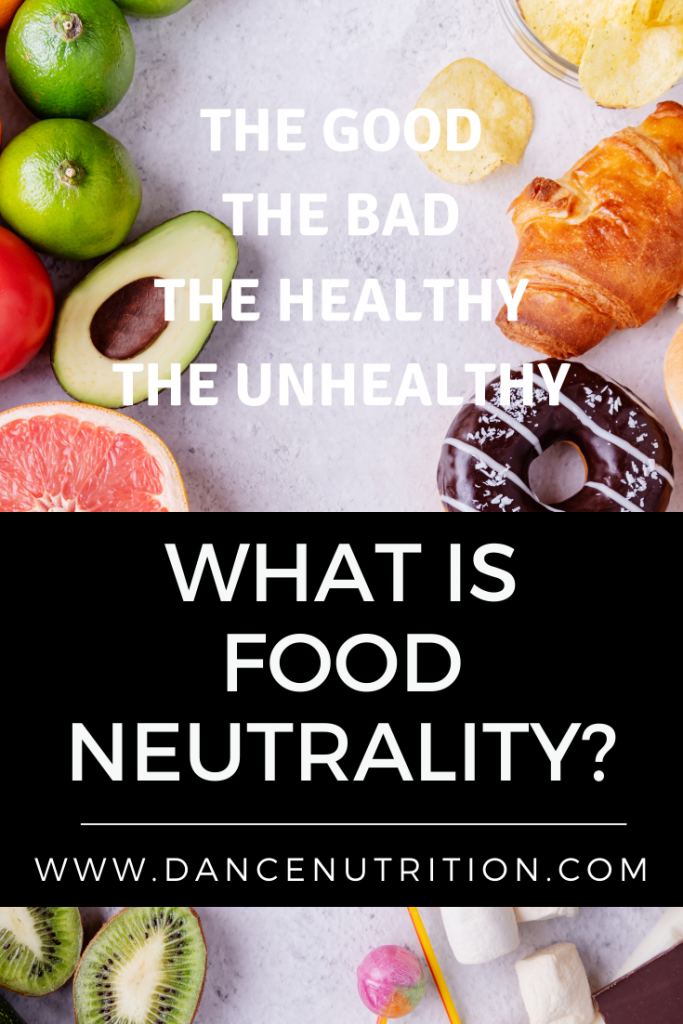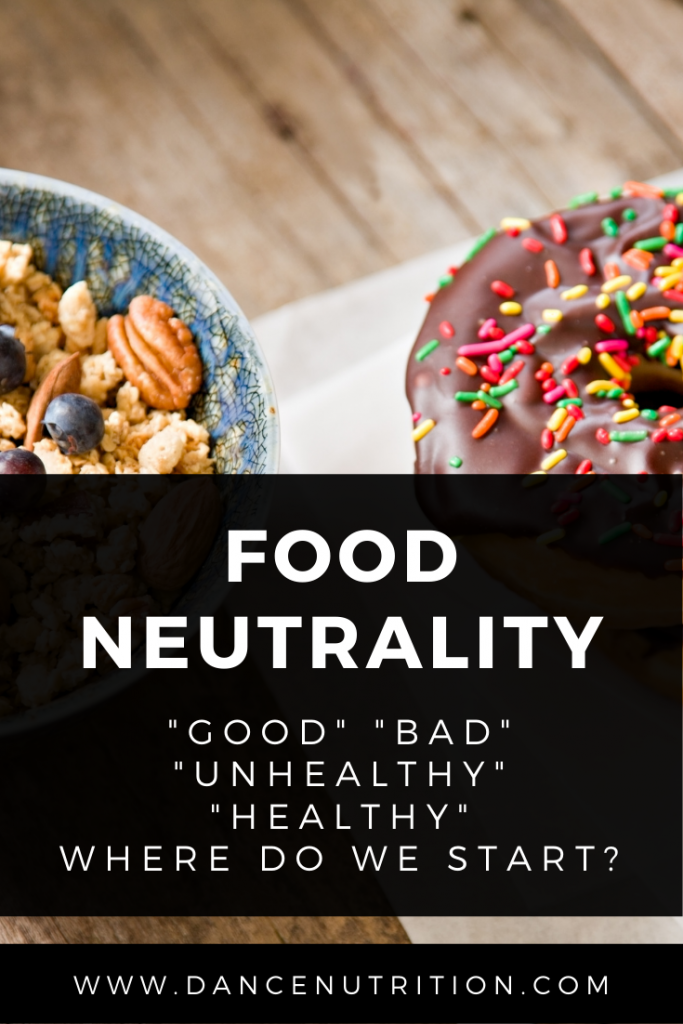After dinner, you eat a cookie. Do you enjoy it and move on? Or does a wave of guilt follow? Or maybe you opt for a salad— do you feel a sense of superiority for choosing the “healthy” option, or do you simply savor the flavors and carry on with your day?
Diet culture has conditioned us to believe that food and exercise define morality. It frames behaviors as “good” or “bad,” depending on whether they align with narrow, often unrealistic, standards of “health” and “wellness.” According to diet culture, you’re “bad” when eating a cookie, and “good” when choosing fruit.
The Problem with Food Moralization
Health is far more complex than the oversimplified ideals pushed by diet culture— ideals that are unattainable for most. In reality, many health outcomes go beyond food and are shaped by factors beyond our control, including social, economic, and environmental influences.
Viewing foods as “good” or “bad” (whether for health or performance) evokes anxiety and guilt, making us vulnerable to an all-or-nothing mindset. When we finally indulge in foods we’ve labeled as “unhealthy,” “junk,” or “empty calories,” we’re left feeling the stress of food guilt.
What Is Food Neutrality?
For dancers, food neutrality means viewing food as fuel, not as “good” or “bad.” A food-neutral lens strips the moral judgment tied to food, allowing you to make choices that satisfy hunger and satisfaction— prioritizing these over external food rules. It’s recognizing that food decisions do not define self-worth and can be made from a place of self-care, not self-control.
Food neutrality also enables you to integrate gentle nutrition without obsession. The focus shifts from restrictive food decisions to those that support your body’s physical, mental, and emotional needs. For example, you begin to recognize that choosing a breakfast richer in whole grains— like overnight oats— allows you to feel energized for longer.
“But, Rachel… I Feel Better When I Eat Healthier!”
Viewing food through a neutral lens doesn’t diminish the importance of nutrition or imply that all foods are nutritionally equivalent. Some foods are more nutrient-dense than others. For instance, the fiber in a serving of broccoli can support digestive health for one dancer, while causing stomach discomfort for another. Similarly, a bag of trail mix with nuts, pretzels, and dried fruit provides more sustained energy when compared to a bag of chips. A dancer with a nut allergy, however, will need to avoid this option for the sake of self-care. This isn’t a judgment about health or value— just a recognition of individual needs. Both approaches are valid.
Food Neutrality In A Wellness-Obsessed World
To embrace food neutrality, we need to challenge diet culture’s obsession with “wellness,” which often masks dieting tendencies. To do so, here are three actionable steps:
#1: Unlearn Dichotomous Messaging
Diet culture elevates certain foods as morally superior to others. To shift your thinking, change “good” and “bad” food thoughts to neutral statements. This enables you to make choices from a place of internal self-care, not external ridicule. Grab a journal and construct ten neutral food thoughts. Here are a few examples:
- Chocolate satisfies my soul.
- Bread gives me energy. I feel better when I include it in my meals.
- Dessert boosts my mood. It’s okay to enjoy it for the emotional satisfaction it brings.
- I felt some indigestion after eating those fries. Next time, I’ll try baking them!
- The cupcake before class left me feeling a bit sluggish during petit allegro. I’ll save my cupcake for after class.
The same goes for foods you’ve deemed to be “healthy” and “clean.” Your fruit smoothie doesn’t have to be the “safe” option because diet culture says so. You can repair your relationship with these foods too. Here are a few examples:
- A crunchy salad sounds refreshing right now, and I’ll add grains for sustained energy.
- I’ll choose the fruit plate tonight. I’m in the mood for a tangy and refreshing option.
- Legume pasta keeps me full and satisfied, perfect for a busy rehearsal day.
- This smoothie is a great way to get some fruits and protein into my day.
- I’m having a wrap because it feels nourishing and balanced.
- Cereal with milk is all I have time for this morning. To make it more satisfying, I’ll use whole milk.
- Savoring a snack of mixed nuts helps keep my energy steady.
- Adding protein powder to my overnight oats helps to keep me feeling fuller and more satisfied throughout the morning.
#2: Give Yourself Judgment-Free Permission to Eat
Removing the rules around food and exercise means you’re not constantly “saving” calories or feeling compelled to “burn off” indulgences. Permission to eat allows you to discover what amounts and types of food feel good to your body. This process of discovery happens only in a judgment-free zone.
During this process, use mindful eating techniques (I dive into these here). How does the food taste? What’s the aroma like? If there’s a specific food that you’re feeling “bad” about, you’ll need to set aside some time for this mindful reflection.
#3: Consider The Whole Value of Your Choices
Food neutrality allows you to consider all aspects of your life— mental, emotional, social, and physical. Use food to nourish and celebrate all parts of yourself, whether seeking comfort, joy, or energy. You can incorporate nutrition information— like food labels and ingredient lists— into your life without feeling confined. First remove the moral judgment, and from there, determine what your body needs at the moment to feel energized, satisfied, and fulfilled.
Key Takeaways: Food Neutrality and A Dancer’s Relationship with Food
Start by shifting your mindset with neutral food statements. Once we understand food neutrality, we can begin intertwining gentle nutrition to help guide (but not hijack) our choices. Here are some examples:
10+ Food-Neutral Statements To Try
- Instead of: “I shouldn’t have eaten that cookie.” Try: “The cookie was delicious and I enjoyed it. It’s part of the experience of living fully.”
- Instead of: “I’m bad for choosing chips over a salad.” Try: “The chips were salty and crunchy, and they satisfied my craving in this moment.”
- Instead of: “I have to eat vegetables to be healthy.” Try: “Vegetables nourish my body and provide energy for the day ahead. I’ll enjoy them when I feel like it.”
- Instead of: “I’m being so unhealthy eating this cake.” Try: “The cake is a sweet addition that brings joy to the occasion. I’m savoring it without guilt.”
- Instead of: “I need to eat low-carb to be healthy.” Try: “Carbs fuel my body, and I’ll enjoy them in ways that feel good to me.”
- Instead of: “I feel guilty for eating ice cream.” Try: “Ice cream is a comforting treat that brings me joy. I can enjoy it without guilt.”
- Instead of: “I have to eat clean foods to feel good about myself.” Try: “Eating a variety of foods, including those I enjoy, makes me feel balanced and nourished.”
- Instead of: “I’m so bad for skipping my workout and eating pizza.” Try: “My body needs rest and nourishment, and I’ll enjoy the pizza as part of my self-care today.”
- Instead of: “I can’t have sweets because I’m trying to be healthy.” Try: “Sweets are a part of life, and I can enjoy them when I want to.”
- Instead of: “I shouldn’t eat pasta— it’s too heavy.” Try: “Pasta is a great energy source, and it pairs perfectly with the other foods I’m craving today.”
Can you list foods that you’ve come to define as being “bad” and/or “good?” For more help, follow me on Instagram and if you started to implement these suggestions, send me a DM. I want to hear from you!




